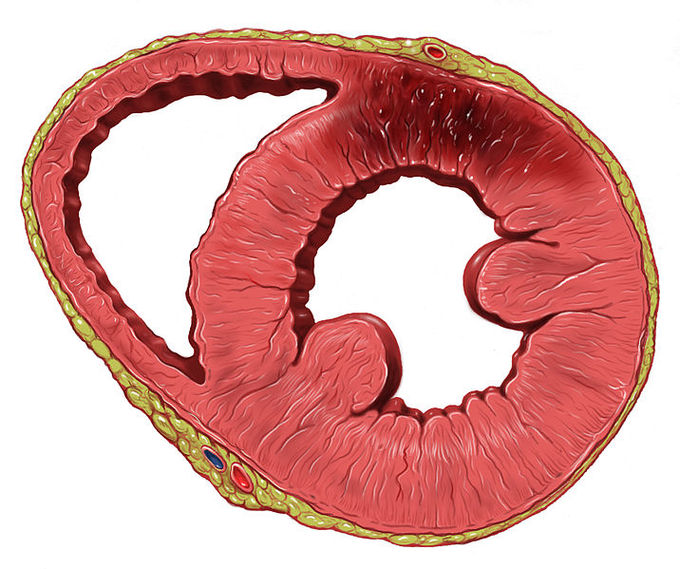what is the muscular middle layer of the heart
17.1C: Layers of the Heart Walls
- Page I.D.
- 7813
The heart wall is comprised of three layers: the outer epicardium, the middle myocardium, and the inner endocardium.
Learning Objectives
- Distinguish betwixt the visceral pericardium, myocardium, and endocardium layers of the heart wall
Key Points
- The epicardium is a thin layer of connective tissue and gross serving as an additional layer of protection for the heart. It is considered a continuation of the serous pericardium.
- The myocardium is the muscle tissue paper of the heart, composed of internal organ muscle cells called cardiomyocytes that receive nervous stimulation from the sinoatrial (Sturmarbeiteilung) and auriculoventricular (AV nodes via the Purkinje fibers.
- Cardiomyocytes are shorter than skeletal myocytes, and contain fewer nuclei. Cardiac muscle is striated.
- The endocardium is composed of epithelial tissue cells that put up a glossy, non-adherent surface for blood collection and pumping and May help baffle contractility.
- An infection operating theatre fervor of the endocardium is called infective endocarditis.
Key Damage
- Johannes Evangelista Purkinje fibers: A parcel of nerve fibers located under the endocardium, which supply nervous impulses to the mycardium's viscus muscle tissues.
- endocardium: A thin serous membrane that lines the interior of the heart and valves.
- cardiomyocyte: A cardiac muscle fiber (or myocyte) in the heart and soul, which makes up the cardiac muscular tissue tissue.
The heart wall is comprised of three layers, the epicardium (outward), myocardium (middle), and endocardium (inner). These weave layers are extremely specialized and do different functions. During cavity contraction, the wave of depolarization from the Sturmarbeiteilung and Av nodes moves from within the endocardial wall finished the myocardial layer to the epicardial surface of the nerve.
Visceral pericardium

The Heart Surround: The wall of the heart is composed of three layers, the thin outer epicardium, the thick middle myocardium, and the very thin inner endocardium. The dark area on the heart rampart is scarring from a former cardiac muscle infarct (heart and soul attack).
The outer layer of the heart wall is the epicardium. The epicardium refers to both the outer layer of the heart and the inner layer of the humor visceral pericardium, which is attached to the outer wall of the heart. The epicardium is a thin layer of elastic connective tissue and fat that serves as an additional layer of protection from harm operating room friction for the heart under the pericardium. This layer contains the coronary blood vessels, which oxygenate the tissues of the heart with a blood supply from the coronary arteries.
Myocardium
The intermediate layer of the bosom wall is the myocardium—the muscle tissue of the heart and the thickest layer of the heart wall in. IT is composed of cardiac muscle cells, Beaver State cardiomyocytes. Cardiomyocytes are specialized muscle cells that contract comparable other muscle cells, but differ in anatomy. Compared to skeletal muscle cells, cardiac muscle cells are shorter and have fewer nuclei. Cardiac muscle tissue is likewise striated (forming protein bands) and contains tubules and gap junctions, unlike skeletal muscle tissue. Due to their continuous rhythmic compression, cardiomyocytes require a dedicated blood append to deliver oxygen and nutrients and remove waste matter products such as carbon dioxide from the cardiac muscle tissue. This blood supply is provided by the coronary arteries.
Endocardium
The intrinsic level of the heart rampart is the endocardium, imperturbable of endothelial cells that provide a smooth, elasticized, non-adherent turn up for blood collection and pumping. The endocardium Crataegus laevigata regulate metabolic waste remotion from affectionateness tissues and act as a barrier 'tween the blood and the cardiac muscle, olibanum controlling the composition of the extracellular smooth in which the cardiomyocytes bathe. This successively can touch on the contractility of the heart.
This tissue as wel covers the valves of the heart and is histologically continuous with the tube endothelium of the major blood vessels entering and leaving the inwardness. The Purkinje fibers are set just below the endocardium and send nervous impulses from the SA and AV nodes out of doors of the heart into the myocardial tissues.
The endocardium can become infected, a serious inflammatory stipulation called unhealthful endocarditis. This and other likely problems with the endocardium may damage the valves and impair the normal flow of blood through the heart and soul.
what is the muscular middle layer of the heart
Source: https://med.libretexts.org/Bookshelves/Anatomy_and_Physiology/Book%3A_Anatomy_and_Physiology_(Boundless)/17%3A_Cardiovascular_System%3A_The_Heart/17.1%3A_The_Heart/17.1C%3A_Layers_of_the_Heart_Walls
Posting Komentar untuk "what is the muscular middle layer of the heart"